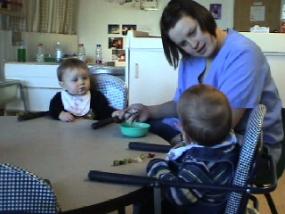Snack Time: Four infants at once

Four infants are enjoying a snack with their teacher. Notice how the teacher reads the infants’ cues as she works to support their emotional and physical needs. Study both the verbal and nonverbal ways she uses to let the infants know that she is attentive.
When Max fusses in his chair and begins to cry, the off camera teacher acknowledges his frustration by saying, “Max, are you hungry too? I know, Max. I’m cooking it. It just takes me a second” (00:41). Notice that as the teacher speaks, Max gazes off camera in her direction. The teacher’s well-timed words of reassurance help Max to self-regulate. With her support he is able to regain control of his emotions and patiently wait a little longer for his food to be prepared. Notice that even while the teacher is off camera, she caringly works to maintain an emotional connection with the group of infants by sharing about what she is doing. She describes the powdered baby food by saying, “It’s like snow!” (00:53). As the teacher returns from tending to a third infant named, Patina, notice that she again offers Max comfort. She gently brushes her hand across the top of his head as if to say, “Thanks for being so patient. Your food is almost ready” (01:15).
The teacher continues to multitask by attending to each child in the group while she sits at the table feeding Max. She tilts her head in order to make eye contact with Porter, and caressingly sweeps his hair to the side as she says, “Hi” (01:56). Later, the teacher notices Max reaching toward his bowl of food (02:51). She treats the infant’s gesture as an intentional act and makes an inference about what he may intend to communicate. The teacher says, “I’m sorry, Max. Am I not doing it fast enough?”, and she quickly gives him two spoonfuls. Near the end of the video clip, she notices Porter bouncing up and down in his chair and imitates his action by gently nodding her head up and down.
Also observe how the infants relate to their teacher. In each instance that the teacher talks to the children from off camera, Porter tilts his head up and leans back in order to look over his chair in her direction (00:47, 00:57). When the teacher carries Patina to another area of the classroom, Max twists his torso and turns his head from side to side in an effort to gaze at the teacher (01:05). The teacher is out of sight but not out of mind. The infants’ behaviors suggest that they desire the teacher’s presence in order to feel secure; they are aware of their emotional attachment to her. Later, when she feeds Max, Porter turns his head toward the teacher and says, “Bah” (02:42). Observe that the teacher treats the infant’s babble as an intentional effort to gain her attention. She turns her head to make eye contact with Porter and says, “Yeah?”
Throughout the video clip, the teacher relates to the children in a calm and soothing fashion. Consider how her consistent rapport helps to foster a positive experience for the children. At the start of the video, when the teacher works to secure the lap belt on Max’s high chair, she adopts a playful tone as she says, “There! How’s that? (Pause) There. Phew! Phew!” A while later, the teacher notices that one of the infants (off camera) is pulling a lunch box off of the table. Notice that the teacher first empathizes with the child about her attraction to the object, and then highlights what she would like the infant to do by softly whispering. She says, “Oh, my gosh! I know how exciting this is, (whispers) but let’s leave this on the table” (02:07).
Length of stand alone master video clip: 4 minutes 5 seconds
Highlight the text above and paste to a document to have your own copy.
Keywords: Infants, Children-Teacher, Teaching, Communication, Attachment, Body
